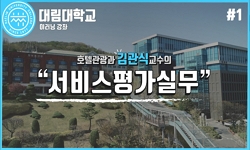Today's beauty salon is industrialized, standardized, and becomes more elegant while the competition among companies is getting stronger all around the industries. With the fierce competition among beauty salons, the customer-oriented service is getti...
http://chineseinput.net/에서 pinyin(병음)방식으로 중국어를 변환할 수 있습니다.
변환된 중국어를 복사하여 사용하시면 됩니다.
- 中文 을 입력하시려면 zhongwen을 입력하시고 space를누르시면됩니다.
- 北京 을 입력하시려면 beijing을 입력하시고 space를 누르시면 됩니다.
미용실의 매스 커스터마이제이션 실행과 고객의 요구수준 = Beauty Salon's Implementation for Mass Customization and the Level of Customer Needs
한글로보기https://www.riss.kr/link?id=T11802237
- 저자
-
발행사항
전주: 전북대학교 대학원, 2009
-
학위논문사항
학위논문(박사) -- 전북대학교 대학원 대학원 , 가정학 , 2009. 8
-
발행연도
2009
-
작성언어
한국어
- 주제어
-
발행국(도시)
전북특별자치도
-
기타서명
Beauty Salon's Implementation for Mass Customization and the Level of Customer Needs
-
형태사항
x, 158p: 그림,표; 26cm
-
일반주기명
전북대학교 논문은 저작권에 의해 보호받습니다.
지도교수:김용숙
참고문헌 : p.132-141 - 소장기관
-
0
상세조회 -
0
다운로드
부가정보
다국어 초록 (Multilingual Abstract)
The research questions addressed in this study are as follows:
First, the study examines factors in mass customization implementation strategies and then categorizes beauty salons and their characteristics.
Second, the study identifies factors in mass customization level of needs which beauty salon's customers want and then categorizes beauty salon's customers and their characteristics.
Third, the study compares and analyzes beauty salon's mass customization implementation strategies and beauty salon's customer's mass customization level of needs.
The results of the study are as follows:
First, through the literature review and analysis, 4 factors and 44 questions in beauty salon's mass customization implementation were derived. The factors are material resources service, human resources service, services related with beauty salon's policy, and services related with technique. The 44 questions were categorized into 6 factors such as staff's technique, communication service, electronic products, monetary support, man-to-man service, and dissatisfaction removal service. Based on these, beauty salons in the samples were categorized into 2 groups (a high implementation group and a low implementation group). A high implementation group had a higher monthly sales and more regular customers and staff. The beauty salons were franchises and the size was spacious in the high group. They were located at fashion street, department store, outlet mall and offered fashionable hair styles. However, a low implementation group had a lower monthly sales and less regular customers and staff. The size of beauty salon was small in the low group. They were located in residential areas and offered basic hair styles. The beauty salon's directors in a high implementation group showed less than 5 years or more than 16 years experience.
Second, through the literature review and analysis, 4 factors and 44 questions in beauty salon's customer's mass customization level of needs were derived. The factors are material resources service, human resources service, services related with beauty salon's policy, and services related with technique. The 44 questions were categorized into 6 factors such as hair technique, beauty salon's staff, individual communication service, sanitary condition and convenience service, and visible service. Based on these, beauty salon's customers in the samples were categorized into 3 groups (a high-level of needs group, a middle-level of needs group, and a low-level of needs group).
A high-level of needs group consisted of female ranging in age from 10s to 20s, college students, and highly educated people. Monthly income was more than 4,000,000 Won. Even though frequency of use of beauty salon was low, the group used the beauty salons which are located at fashion street. The group preferred their own style which is unrelated with fashion. The group got hair information through TV or on the street.
A middle-level of needs group consisted of female ranging in age from 30s and 40s married working women and women with high school diploma. Monthly income was between more than 2,000,000 Won and less than 4,000,000 Won. The group used hair salons once or twice monthly which are located at residential areas. The group preferred basic and simple style and got hair information through the monthly magazine.
A low-level of needs group consisted of female ranging in age from 10s and 20s, middle aged women, married working women, and college students. Monthly income was less than 2,000,000 Won. The group used beauty salons once a month which are located at department store and mart. The group preferred fashionable style and got hair information through the hair magazine.
Third, the results of comparing and analyzing beauty salon's mass customization implementation strategies and beauty salon's customer's mass customization level of needs showed that beauty salon's customer's level of needs was higher than beauty salon's implementation in all 4 factors. The results of comparing 6 mass customization showed that each factors between beauty salons and customers were in discord.
Today's beauty salon is industrialized, standardized, and becomes more elegant while the competition among companies is getting stronger all around the industries. With the fierce competition among beauty salons, the customer-oriented service is getting popular. Since the beauty industry has characteristics which immediately show customer's satisfaction, a customer-oriented service system that could maximize each customer's satisfaction is needed in beauty industries. Therefore, it is necessary to identify mass customization which could satisfy each customer's needs through various goods and better service. The study which identifies the factors of mass customization influencing beauty salon's customers and hair industries has a significant implication. The purpose of this study is to clarify Beauty Salon's Implementation for Mass Customization and the Level of Customer Needs. It is also to be helpful in devising the strategies for efficient mass customization which are suitable for beauty salon's characteristics and maximize each customer's satisfaction.
The research questions addressed in this study are as follows:
First, the study examines factors in mass customization implementation strategies and then categorizes beauty salons and their characteristics.
Second, the study identifies factors in mass customization level of needs which beauty salon's customers want and then categorizes beauty salon's customers and their characteristics.
Third, the study compares and analyzes beauty salon's mass customization implementation strategies and beauty salon's customer's mass customization level of needs.
The results of the study are as follows:
First, through the literature review and analysis, 4 factors and 44 questions in beauty salon's mass customization implementation were derived. The factors are material resources service, human resources service, services related with beauty salon's policy, and services related with technique. The 44 questions were categorized into 6 factors such as staff's technique, communication service, electronic products, monetary support, man-to-man service, and dissatisfaction removal service. Based on these, beauty salons in the samples were categorized into 2 groups (a high implementation group and a low implementation group). A high implementation group had a higher monthly sales and more regular customers and staff. The beauty salons were franchises and the size was spacious in the high group. They were located at fashion street, department store, outlet mall and offered fashionable hair styles. However, a low implementation group had a lower monthly sales and less regular customers and staff. The size of beauty salon was small in the low group. They were located in residential areas and offered basic hair styles. The beauty salon's directors in a high implementation group showed less than 5 years or more than 16 years experience.
Second, through the literature review and analysis, 4 factors and 44 questions in beauty salon's customer's mass customization level of needs were derived. The factors are material resources service, human resources service, services related with beauty salon's policy, and services related with technique. The 44 questions were categorized into 6 factors such as hair technique, beauty salon's staff, individual communication service, sanitary condition and convenience service, and visible service. Based on these, beauty salon's customers in the samples were categorized into 3 groups (a high-level of needs group, a middle-level of needs group, and a low-level of needs group).
A high-level of needs group consisted of female ranging in age from 10s to 20s, college students, and highly educated people. Monthly income was more than 4,000,000 Won. Even though frequency of use of beauty salon was low, the group used the beauty salons which are located at fashion street. The group preferred their own style which is unrelated with fashion. The group got hair information through TV or on the street.
A middle-level of needs group consisted of female ranging in age from 30s and 40s married working women and women with high school diploma. Monthly income was between more than 2,000,000 Won and less than 4,000,000 Won. The group used hair salons once or twice monthly which are located at residential areas. The group preferred basic and simple style and got hair information through the monthly magazine.
A low-level of needs group consisted of female ranging in age from 10s and 20s, middle aged women, married working women, and college students. Monthly income was less than 2,000,000 Won. The group used beauty salons once a month which are located at department store and mart. The group preferred fashionable style and got hair information through the hair magazine.
Third, the results of comparing and analyzing beauty salon's mass customization implementation strategies and beauty salon's customer's mass customization level of needs showed that beauty salon's customer's level of needs was higher than beauty salon's implementation in all 4 factors. The results of comparing 6 mass customization showed that each factors between beauty salons and customers were in discord.
목차 (Table of Contents)
- 표목차 iv
- 그림목차 vi
- Abstract vii
- 제 1 장 서 론 1
- 제 1 절 연구의 필요성 1
- 표목차 iv
- 그림목차 vi
- Abstract vii
- 제 1 장 서 론 1
- 제 1 절 연구의 필요성 1
- 제 2 절 연구의 목적 4
- 제 3 절 논문의 체계 5
- 제 2 장 이론적 배경 6
- 제 1 절 매스 커스터마이제이션 6
- 1. 매스 커스터마이제이션의 개념 및 등장배경 6
- 2. 매스 커스터마이제이션의 적용 사례 11
- 3. 매스 커스터마이제이션 관련 선행 연구 19
- 제 2 절 미용실 경영 24
- 1. 미용실 경영현황 24
- 2. 미용서비스 27
- 3. 미용실 경영과 미용 서비스 관련 선행 연구 31
- 제 3 절 미용실 고객의 요구수준 35
- 1. 미용실 고객 35
- 2. 미용실 고객 관련 선행 연구 36
- 제 4 절 미용실의 매스 커스터마이제이션 41
- 1. 개념과 도입배경 41
- 2. 실행 적용 사례 42
- 제 3 장 연구 방법 및 내용 45
- 제 1 절 연구문제 및 용어 정의 45
- 1. 연구문제 45
- 2. 용어의 정의 49
- 제 2 절 측정 도구 51
- 1. 측정 도구의 구성 51
- 제 3 절 자료 수집 및 분석방법 60
- 1. 자료 수집 60
- 2. 표본의 구성 60
- 3. 분석 방법 71
- 제 4 장 연구 결과 및 논의 72
- 제 1 절 미용실의 매스 커스터마이제이션 실행수준 72
- 1. 매스 커스터마이제이션 실행수준 요인체계 72
- 2. 매스 커스터마이제이션 실행수준 요인분석 78
- 3. 미용실의 유형화 및 유형화된 집단의 특성 83
- 제 2 절 미용실 고객의 매스 커스터마이제이션 요구수준 88
- 1. 매스 커스터마이제이션 요구수준 요인체계 88
- 2. 매스 커스터마이제이션 요구수준 요인분석 94
- 3. 유형화 및 유형화된 집단의 특성 99
- 제 3 절 미용실의 매스 커스터마이제이션 실행수준과 107
- 1. 매스 커스터마이제이션 실행수준과 요구수준 요인체계 비교107
- 2. 매스 커스터마이제이션 실행수준과 요구수준 요인분석 결과 비교 120
- 제 5 장 결론 및 제언 125
- 제 1 절 요약 및 결론 125
- 제 2 절 시사점 및 제언 129
- 1. 마케팅 시사점 129
- 2. 연구의 한계 및 제언 131
- 참고 문헌 132
- 부 록 142











